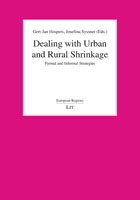- kennisvanstadenregio
- Kennisdossiers
- Kennisdossier Bevolkingsdaling
- Publicaties over krimp (2022-2006)
- Dealing with Urban and Rural Shrinkage
Inhoud
- Bevolkingsdaling: wat is het?
- Beleid voor bevolkingsdaling: een korte geschiedenis
2.1 De krimp bestrijden
2.2 Bewustwording: Eerste Actieplan Bevolkingsdaling – 2009
2.3 Programmering en uitvoering: Tweede Actieplan Bevolkingsdaling – 2016
2.4 Provincies
2.5 Gemeenten - Bevolkingsontwikkeling en prognoses
3.1 Inleiding
3.2 Drijvende krachten achter bevolkingsontwikkeling
3.3 Bevolkingsontwikkeling in Nederland
3.4 De zeggingskracht van prognoses
3.5 Onwaarschijnlijkheden en scenario’s
3.6 Conclusie - Ontwikkelingen per domein
4.1 Wonen
4.2 Gezondheid en zorg
4.3 Onderwijs
4.4 Regionale economie en arbeidsmarkt
4.5 Bereikbaarheid - Praktijkvoorbeelden
5.1 Aanpak huisartsentekort
5.2 Toekomstgericht bouwen in Biggekerke
5.3 Zelfrijdende shuttlebus bij Ommelander ziekenhuis
5.4 Toekomst wonen in Beltrum
5.5 Gefaseerde strategie voor de herontwikkeling van Rolduckerveld
Contact
Dealing with Urban and Rural Shrinkage
Formal and informal strategies
Auteur Gert-Jan Hospers, Josefina Syssner (red.)
Verschijningsdatum februari 2018, LIT Verlag (in de reeks Regionen in Europa / European Regions)
Omvang 146 pagina's
Prijs 34.90 euro
More and more places across the world are confronted with demographic shrinkage. This edited volume discusses how local communities in city and countryside have responded to the challenge of population decline. It is argued that formal strategies based on political and public sector decisions are only one way to deal with shrinkage. Informal adaptation strategies developed by civil society play an important role as well. To illustrate this, the book brings together a variety of theoretical perspectives, case studies and policy lessons from both urban and rural areas.
Bestel de publicatie Dealing with Urban and Rural Shrinkage


